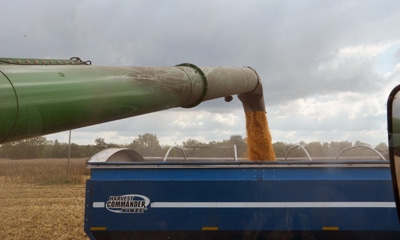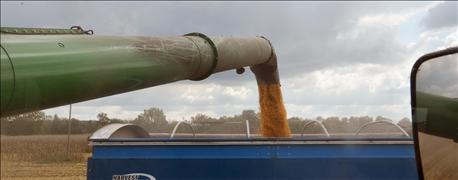
There was no joy in Mudville when mighty Casey struck out! Nearly everyone has heard that epic tale. Borrowing a line from it and changing it slightly, “There was no joy in Cornville once nasty diseases moved in.” The late but dramatic appearance of several diseases contributed to a less-than-happy harvest in parts of the Corn Belt.
Here are five reasons why corn harvest, usually the capstone event of the year, didn’t turn out to be as much fun for some people this year.

DISEASE AND DUST: Even if your corn yielded well, which it didn’t everywhere, other factors may have dampened your spirits this harvest.
1. Leaf diseases helped slam the door on many cornfields early in the fall.
Name the disease — gray leaf spot, southern rust, common rust. Depending on where you lived, one or more of these diseases likely came in hard near the end of the season. When the disease came in and warm, wet conditions continued into September, many cornfields gave up. Chris Perkins, CPS manager at Otwell, Ind., says some fields planted in late May appeared so dead and beat up in September that it looked like a field in January. In his area, southern rust was the main culprit.
2. Choking dust and chaff occurred.
When one farmer started up his combine after stopping to unload, dust rolled out of the feederhouse. His passenger thought something was wrong. The farmer assured him it was just all the dust inside the machine from handling corn eaten up by disease.The culprit in that field was gray leaf spot. Where southern rust took over, farmers talked about an orange haze, and combines and even clothes that turned orange.
3. Down corn complicates harvest.
Even if you harvested in September, some corn was already falling over. Dave Nanda, a plant breeder and crops consultant in Indianapolis, Ind., says when he did the push test on 100 stalks down a row on corn planted in late April, many stalks flunked the test and didn’t snap back. And that was in early September!
Nanda believes stalk rot became rampant in some hybrids where leaf diseases stressed the plants in late summer. The stalk rot was caused by a different fungus than the one causing the leaf disease, but the leaf disease opened the door.
4. Yields were disappointing in several places.
Yes, yields approaching 300 bushels per acre have been reported. So have yields less than 100 bushels per acre, both in northern and southern counties in key states. Some expecting 220-bushel corn harvested 220-bushel corn. Others expecting 220-bushel corn settled for 150 bushels per acre or less. The impact of several factors, including delayed planting, warm dry spells and diseases late in the year took their toll.
5. Low prices and costly dockage hurt.
One farmer who was harvesting 200-bushel corn still said it was hard to get excited when it was going to the elevator for $3.10 per bushel. He didn’t have enough ear rot to get damage, but others did. Damage as high as 15% due to kernels damaged by a variety of ear rots ate into that $3.10 price in some cases.
All in all, there have been better years in Cornville, good yields or not!
About the Author(s)
You May Also Like




